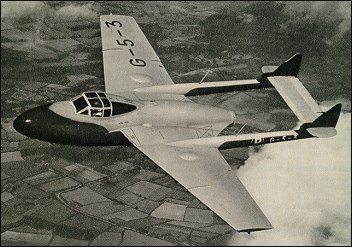|
| The Venom was a straightforward development of the Vampire, designed to accommodate the de Havilland Ghost engine and with aerodynamic refinements enabling it to take full advantage of the increased power. The nacelle and tail assembly were substantially similar to those of the Vampire. However the wings were entirely new, with square tips, very thin section and jettisonable long-range wingtip tanks.
The Venom FB.1 was the first version for the RAF: a day fighter and fighter-bomber with provision for bombs and rockets in addition to the standard four 20 mm Hispano Mk 5 cannon in the nose. The prototype of this version flew for the first time on 2 September 1949. This was followed for the RAF by the Venom NF.2 two-seat night and all-weather fighter; Venom NF.3 development with special combat equipment; and Venom FB.4 with hydraulically operated ailerons and other improvements. Export models of the Venom were also produced, among which the Swedish Air Force received NF.51 (similar to NF.2).
The Sea Venom was a two-seat naval all-weather fighter which evolved from the NF.2. It had folding wings, catapult and arrester gear. The Royal Navy received the F(AW).20; F(AW).21 improved version with special combat equipment and Martin-Baker ejection seats; and the F(AW).23 with a more powerful Ghost 105 engine. Sea Venoms were also operated by the French Navy which built the NF.52 under licence with a Fiat-built Ghost 48 engine and the Royal Australian Navy which received NF.53 (similar toF(AW).21). British-operated Venoms and Sea Venoms were withdrawn from operational service in 1962 and 1960 respectively.

| CREW | 1 |
| ENGINE | 1 x DH "Ghost", 23.5kN |
| WEIGHTS |
| Take-off weight | 7150 kg | 15763 lb |
| DIMENSIONS |
| Wingspan | 12.7 m | 42 ft 8 in |
| Length | 10.1 m | 33 ft 2 in |
| Height | 1.9 m | 6 ft 3 in |
| Wing area | 25.9 m2 | 278.79 sq ft |
| PERFORMANCE |
| Max. speed | 920 km/h | 572 mph |
| Ceiling | 12200 m | 40050 ft |
| Range w/max.fuel | 1100 km | 684 miles |
| ARMAMENT | 4 x 20mm cannons, 900kg of bombs or missiles |
 | A three-view drawing (800 x 721) |
| Anonymous, 20.10.2021 00:48 The sad fact is that the British, who had led the world in aircraft development in 1945, had completely lost their edge after only four years. Note that the Venom, which was first flown in 1949, had a top speed of only 572 mph and a ceiling of only 40,000 feet. That performance was hopelessly inadequate in comparison with the contemporary North American Sabre and Mig-15. RAF fighter squadrons were getting Venoms when they should have been getting Hawker Hunters. I'm not saying that the Venom was a bad aircraft, simply that it was outdated before the prototype ever even flew. reply | | Les Neaves, e-mail, 09.10.2010 16:27 I flew both Vampire and the Venom in the 1950's, with 145 Squadron in Germany. The Venom was supposed to reach 0.94 Mach, I only managed to reach 0.91 Mach and that was after reaching 42,000 Ft, rolling it slowly onto it's back and pulling through into a dive. Even so it was a nice aircraft to fly. reply | | John Daly, e-mail, 05.03.2010 07:41 The Mark 4 was the most delightful aircraft. Splendid stable gun /rocket platform for air to ground and plenty of power (NO Navigator nor radar!) Could loop it at 40,000 ft. Bang seat, power controls. Perfect! reply | | Don Huckle, e-mail, 14.01.2010 13:53 The NF2 was a stopgap all weather fighter rushed into service in spite of Farnborough`s misgivings. It carried the outdated AI Mk10 which came from the Mosquito. It was probably as well because the first time we fired the guns the recoil smashed through the bulkheads and destroyed the radios. When fired after dark the muzzle flash caused the pilot to lose his night vision. Unlike the Sea Venom ejector seats were not fitted reply |
|
Do you have any comments?
|
| 
COMPANY
PROFILE
All the World's Rotorcraft
|








